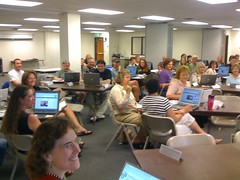I spent about an hour and a half on a social network yesterday. It was probably the most time that I’ve spent on a single SN in my life — the most that I’ve been drawn in to the experience. I say that because I get the sense that this is what is supposed to happen — that you get drawn in. I’ve just visited again and found myself engaged in a discussion on the new Class Blogmeister group that was set up by Diane Scott. I also linked into Larry Anderson’s profile page from a search for Second Life among the network’s members. Cool page, Larry, by the way. When I saw that he had his Second Life avatar’s name on his page, I rushed back to my profile and added in my Twitter login and my Second Life name, Suriawang Dapto, along with a link to my virtual office there.
 So now I’m closing the window to avoid getting distracted again. But the question I ask myself is, “Am I doing education here (teaching or learning) or am I doing Networking.” Not fair to answer this seriously without a whole lot more experience — and I can’t promise that I will, as I spend so much time doing education and networking.
So now I’m closing the window to avoid getting distracted again. But the question I ask myself is, “Am I doing education here (teaching or learning) or am I doing Networking.” Not fair to answer this seriously without a whole lot more experience — and I can’t promise that I will, as I spend so much time doing education and networking.
I’ve mentioned this in some of my presentations, that I do not believe that we – educators older than 30 (arbitrarily chosen age) – truly understand social networks yet. For instance, we’re trying to grow individual and independent social networks out of every discipline, school level, and just about any other probable community of educational interest. I’ll bet I’ve been contaced by e-mail or phone call by no fewer than ten people over the past month, each wanting me to see their social network. “This social network is going to revolutionize physical education!”
What strikes me is that our students make it work with just one. The three main choices, as far as I know, are MySpace, Bebo, and Facebook, the later seeming to be the one of choice at present. So why didn’t we figure out how to use Facebook as the social network for NECC. I looked there for a group for NECC. I probably won’t do that again :-/
So, anyway, I keep wondering about this. What’s the point, beyond costing time, which I guess many of our students have more to spend. It seems to me, that the true potential for all of this, and something that I don’t even think Facebook has truly captured yet, is the profile. What bothers me about social networks is that they have walls. It’s a weekness of Ning, in my opinion, that there do not seem to be easy and logical ways for us to connect to each other, based on common interests, regardless of the networks we’ve joined. There are certainly security issues. But for me to learn, to grow, to solve problems, and accomplish goals, I need to connect to people and resources that help me do that.
I guess I’m picturing social networks, whose boundaries become much more porous, and profiles, whose reach extends out into the Net in ways that attract connections based partly on how we populate our profiles, but also having certain aspects of our profiles populated automatically by what we are doing. There was a search tool out there, many years ago, called Kenjin [Feb 2000 PCWorld Review]. It would read the text from the active window on your PC screen, analyze the text, pick out the major themes, and then comb the Internet for links related to those subjects.
I wonder about a tool that would maintain a profile for us, based on how we’ve populated it, but also based on what we are doing with information. The profile would be fully customizable, the owner able to determine what would be public, what would be private, and what would be actionable in actively or passively connecting to other people and resources. Then temporary or permanent social networks could be created or create themselves around people of similar interests, concerns, problems, or goals.
This entry’s gotten to long already, but I’m continuing to try to hash this out.
 Description: The world is flattening, and not just economically. Learn about three converging conditions that are redefining education?and providing windows to the future. In this presentation, I will seek to examine and factor together three foundational disruptive conditions that are converging on our schools, each serving to disrupt schooling as we know it, yet also providing direction as we work toward new models for teaching and learning — Learning 2.0.
Description: The world is flattening, and not just economically. Learn about three converging conditions that are redefining education?and providing windows to the future. In this presentation, I will seek to examine and factor together three foundational disruptive conditions that are converging on our schools, each serving to disrupt schooling as we know it, yet also providing direction as we work toward new models for teaching and learning — Learning 2.0.
 So now I’m closing the window to avoid getting distracted again. But the question I ask myself is, “Am I doing education here (teaching or learning) or am I doing Networking.” Not fair to answer this seriously without a whole lot more experience — and I can’t promise that I will, as I spend so much time doing education and networking.
So now I’m closing the window to avoid getting distracted again. But the question I ask myself is, “Am I doing education here (teaching or learning) or am I doing Networking.” Not fair to answer this seriously without a whole lot more experience — and I can’t promise that I will, as I spend so much time doing education and networking. ![This is a screen shot from the Agrega catalog, a 98 page PDF document. [Click to enlarge] Picture of Agrega Catalog](http://davidwarlick.com/images/agrega_sml-20080622-072131.jpg) I hope that
I hope that  I suspect that it has been traditionally believed that the last time you’d want to do staff development was May and early June, just after the school year is over (Northern Hemisphere). Teachers just aren’t ready for it. The tests are behind them, the students are behind them, and vacation is just a few weeks, days, or hours away.
I suspect that it has been traditionally believed that the last time you’d want to do staff development was May and early June, just after the school year is over (Northern Hemisphere). Teachers just aren’t ready for it. The tests are behind them, the students are behind them, and vacation is just a few weeks, days, or hours away. Just a couple of quick comments before I get into networks. First, I saw my first
Just a couple of quick comments before I get into networks. First, I saw my first  Then, on Monday, at 12:30, in the HGCC Lila Cockrell Theatre, I’ll talk about our students and our worlds, describing three disruptive conditions that are converging on every school, classroom, teacher, and learner. It’s a fairly big-picture session that I have not done at NECC before, though it is being increasingly requested by conference planners as a large group general addresses.
Then, on Monday, at 12:30, in the HGCC Lila Cockrell Theatre, I’ll talk about our students and our worlds, describing three disruptive conditions that are converging on every school, classroom, teacher, and learner. It’s a fairly big-picture session that I have not done at NECC before, though it is being increasingly requested by conference planners as a large group general addresses.
 This is perhaps one of the most interesting and practical uses of a blog that I’ve seen. It’s author, Jonathan “Jeep” Briones, walked up to me, during the EdTech conference in Honolulu, told me that he had a blog called
This is perhaps one of the most interesting and practical uses of a blog that I’ve seen. It’s author, Jonathan “Jeep” Briones, walked up to me, during the EdTech conference in Honolulu, told me that he had a blog called  As it turns out, Jeep was the sound guy for my keynote, and as we were talking later, he mentioned that his blog was designed to help people learn to play the ukulele. I was intrigued then. Each post is a different song that he helps you learn to play. It includes an mp3 file of him playing and singing the song (
As it turns out, Jeep was the sound guy for my keynote, and as we were talking later, he mentioned that his blog was designed to help people learn to play the ukulele. I was intrigued then. Each post is a different song that he helps you learn to play. It includes an mp3 file of him playing and singing the song (
 A while back, I was talking about trends that influence education with a group of tech directors in Texas, and captured a shot of a young man who was playing a video game during the presentation. This morning I got a comment on a
A while back, I was talking about trends that influence education with a group of tech directors in Texas, and captured a shot of a young man who was playing a video game during the presentation. This morning I got a comment on a 


 Just a quick note. It’s almost show time and I’m by my self getting my head together for my address. Will Richardson keynoted yesterday, so it’s going to take me about ten minutes to fill in the little bit that he left out. Another one for my list. Don’t follow kids, school board members who’ve just read The World is Flat, kindergarten teachers, and now — don’t follow Will Richardson.
Just a quick note. It’s almost show time and I’m by my self getting my head together for my address. Will Richardson keynoted yesterday, so it’s going to take me about ten minutes to fill in the little bit that he left out. Another one for my list. Don’t follow kids, school board members who’ve just read The World is Flat, kindergarten teachers, and now — don’t follow Will Richardson.